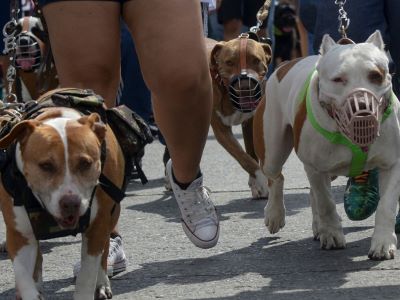In response to tragic dog attacks, the UK’s Dangerous Dogs Act is on the brink of a significant modification.

This decision has sparked renewed interest in the Dangerous Dogs Act, which was enacted in 1991 to address concerns about dog attacks. Let’s understand how does the Dangerous Dogs Act affects you and your dog.
While this act was initially introduced with the intention of reducing dog attacks, critics argue that it unfairly targets specific breeds and fails to address responsible ownership and training. The proposed changes to the Dangerous Dogs Act aim to address some of the these concerns.
How Does the Dangerous Dogs Act Affect You and Your Dog?
The Dangerous Dogs Act aimed at controlling and regulating certain breeds of dogs that are considered dangerous. It was originally enacted in 1991 and has since been amended. The primary purpose of this act is to protect the public from dog attacks and to ensure responsible dog ownership.
The act specifically bans the ownership, breeding, sale, and exchange of four breeds or types of dogs: Pit Bull Terrier, Japanese Tosa, Dogo Argentino, and Fila Brasileiro[1].

If you own one of these breeds or a dog that resembles them in characteristics, you must adhere to strict regulations. Here are some of them:
- Muzzling: When in public places, these dogs must wear a muzzle to prevent them from biting or attacking.
- Leashing: Dogs must be on a lead and under control at all times when outside their home. This ensures that they cannot approach strangers or other animals in an aggressive manner.
- Insurance: Owners are legally required to have liability insurance specifically for their banned breed. This insurance helps cover potential damages or injuries caused by the dog.
It’s important to note that these regulations apply not only to banned breeds but also to any dog that exhibits aggressive or dangerous behaviour, regardless of its breed. Responsible ownership, training, and socialization of all dogs are strongly encouraged to prevent such behaviour.
Penalties for Violations
These penalties underscore the importance of adhering to the act’s provisions. Failure to do so not only results in legal consequences but also poses risks to public safety.
Owners who do not comply with the regulations can face substantial fines. In cases of serious violations, individuals may be sentenced to prison. In extreme cases, if a dog poses an immediate threat to public safety, it can be seized and euthanized.
The Need for the Act
Let’s look at some of the incidents that led to the enactment of the Dangerous Dogs Act in 1991[2]:
| Date | Dog Breed | Victim | Circumstances |
|---|---|---|---|
| 9 Dec 1986 | Jack Russell | Amy Victoria Bourne | Baby found dead in carrycot with skull perforations and fractures caused by dog bites. |
| 18 Feb 1991 | Alsatian | William Roach | Victim was savaged to death by his own dog as his wife tried to rescue him. |
| 22 Dec 1994 | Bull Terrier | Ashley Wilson | A dog attack just before Christmas; a bull terrier savaged a month-old girl. The baby died two hours later from brain injuries. |
| 1 Jul 2005 | American Bulldog | Liam Eames | The baby crawled towards the dog, and it attacked, only letting go once the other household dog intervened. The child was pronounced dead an hour later from head and neck wounds. |
| 20 Mar 2015 | American Bulldog | Rhona Greve | The victim was savaged to death by his own dog as his wife tried to rescue him. |
| 8 Nov 2021 | American Bully XL | Jack Lis, M, 10 years | A ten-year-old boy was killed by a “large and powerful” dog while visiting a school friend’s house. The dog was notably named “Beast.” |
| 23 May 2022 | American Bully XL | Unnamed man | A man died after being bitten by his daughter-in-law’s dog and went into cardiac arrest. The man was pronounced dead at the scene. |
| 4 Sep 2024 | Suspected American Bully XL | Ian Price | Despite the best efforts, it became clear that nothing more could be done to save him. He was confirmed deceased. |
Several of these attacks involved breeds that were perceived as particularly dangerous or had a history of aggressive behaviour. The incidents painted a heartbreaking picture of the risks associated with dog ownership and the potential consequences for public safety.

How It Has Affected So Far?
The designers of the Dangerous Dogs Act intended not only to ban certain breeds but also to impose strict regulations on their ownership. Here are some outcomes of this act:
- Safer Public Spaces: By specifically addressing breeds known for their aggressive tendencies and imposing control measures, the legislation has contributed to reducing the likelihood of severe dog attacks in parks, neighbourhoods, and other communal areas. This has, in turn, improved the sense of security among the general public.
- Increased Awareness: The act has succeeded in raising awareness about the importance of responsible dog ownership. This awareness has led to more responsible pet owners who take proactive measures to ensure their dogs are well-behaved and pose no threat to others.
- Criticism and Controversy: Critics argue that its breed-specific focus can be overly restrictive and may unfairly target certain breeds. They suggest that the act fails to address the root causes of dog aggression, such as poor socialization, inadequate training, or neglectful ownership.
- Challenges for Owners: While the intentions are to improve public safety, responsible owners of banned breeds or dogs that exhibit aggressive behaviour may find it burdensome to comply with the strict requirements. This can lead to frustration and inconvenience for those who have taken steps to ensure their pets are well-behaved.
The ongoing debate surrounding this act highlights the complexity of balancing public safety with the rights and responsibilities of dog owners

The Call for the Change
The recent decision to add the American XL bully dogs to the list of banned breeds in the UK has been prompted by this breed being involved in high-profile attacks across the country.
Adding American XL bully dogs to the list of banned breeds aims to reduce the risk of dog attacks and ensure public safety.
Scientific studies and expert opinions help inform policymakers about the potential risks associated with certain breeds and guide decisions regarding breed-specific legislation. To address these mounting concerns, policymakers and legislators have deemed it necessary to take action.
FAQs
What Dogs Are Dangerous Under the Dangerous Dogs Act?
When the Dangerous Dogs Act was introduced in the UK in 1991, it banned four breeds – the pit bull terrier, Japanese tosa, dogo Argentino and fila Brasileiro. It was brought in after a spate of 11 serious attacks that year, including the mauling of a six-year-old girl as she walked with her family in Bradford
How Does the Dangerous Dogs Act Affect You and Your Dog?
The Dangerous Dogs Act is legislation that can deem your dog dangerously out of control if it injures, threatens or frightens someone. Your dog could also be considered dangerous if it attacks another animal, or if the owner of another animal believes they’ll be injured if they try to stop an attack by your dog.
How Do You Deal With Dangerous Dogs?
Stay as calm as you can. Use a firm voice. This isn’t to “assert dominance,” but to maintain as much control of yourself and the situation as possible, and to make any commands or cues you give the dog as understandable as possible. Stand or stay upright.
Summary
In a rapidly changing world of dog ownership and public safety, one thing is crystal clear – the Dangerous Dogs Act must adapt and evolve. It’s not just a legal document; it’s a living, breathing framework that needs to keep pace with the times.
Above all, public safety remains paramount. But it’s equally crucial that we don’t forget the well-being of the dogs themselves. Responsible ownership isn’t just about obeying the law; it’s about training, socializing, and genuinely caring for our dogs.
So, let’s ask ourselves: How do we ensure a safer world for everyone, without unfairly burdening those who love and care for their dogs responsibly?
Reference:
- Participation, E. (n.d.). Dangerous Dogs Act 1991 | Legislation.gov.uk
- Wikipedia contributors. (2023d). List of fatal dog attacks in the United Kingdom | Wikipedia.



